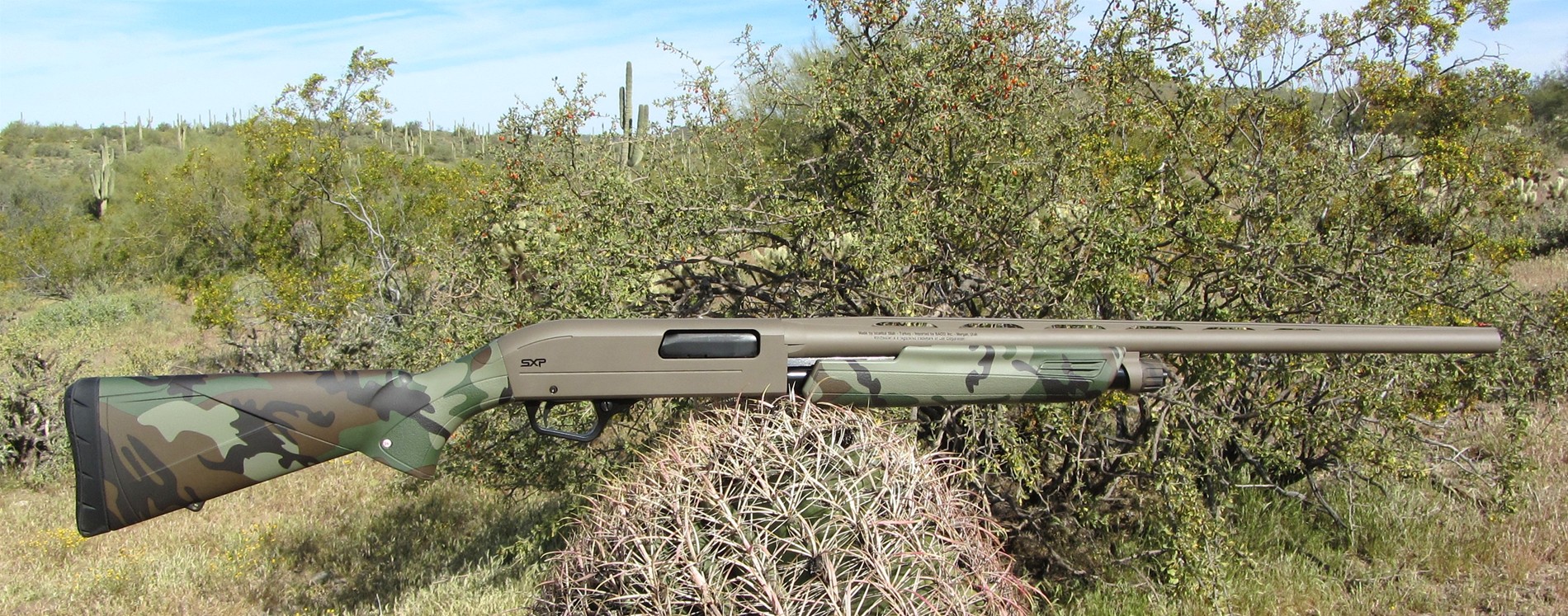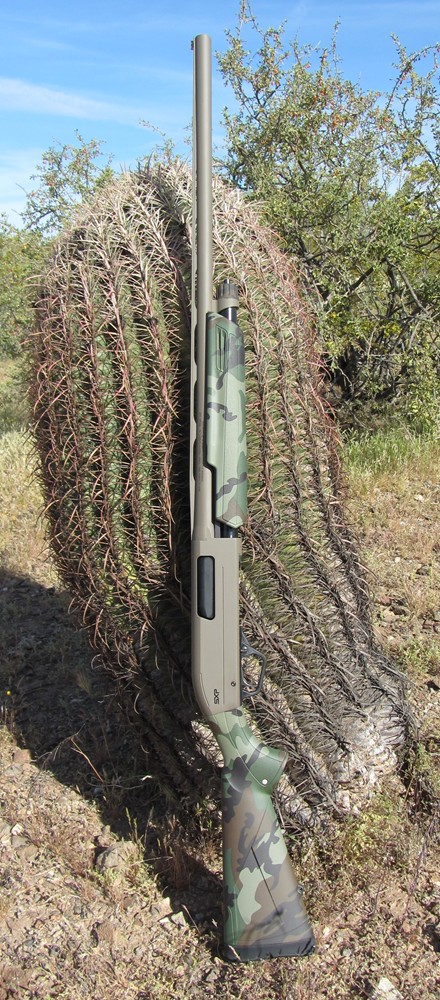
| Articles | Documents | Equipment | Events | Links | Membership | Miscellaneous | Scrapbook | Targets | What's New |
| The Winchester Super X Pump | April 2023 | |||
| Dan Martinez | ||||
|
Gerhard sent me the preceding story,
then suggested that we make this a shotgun special edition of the newsletter, knowing
that my son Ben and I had just picked up a couple of new Winchester SXP pump shotguns.
I was not planning to write about the SXPs, but OK, sounds like a good idea.
My shotgunning experience began with the inheritance of my Dad’s 16 gauge Remington
Wingmaster of 1960’s vintage. I passed that gun down to Ben when I got a Remington
Model 1100 in 16 gauge in 2004. Because of my Dad, Ben and I have been dedicated 16
gauge shooters ever since. However, because of duck and turkey hunting, I eventually
added a 24” Benelli Nova pump gun in 12 gauge to my collection.
Currently, due to ongoing ammo constraints, exacerbated by Bidenflation, 16 gauge shells
have been harder to find, and expensive when they are found. Most recently I found 16
gauge Federal 1 ounce #7½ (basic dove and quail spec) shells at Sportsman’s for $20.99
a box. Disheartening.
It's fun to be a quirky 16 gauge shooter as long as the cost premium of 16 gauge over 12
gauge is only a buck or two per box, but that price is about double the cost of the best
prices I am seeing for 12 gauge right now. I have a decent stockpile of 16 gauge at the
moment, so I could be shooting those, but the cost of replacing what I shoot is causing me
to be a cautious 16 gauge hoarder for now. For Ben, it’s doubly tough to afford 16 gauge
on a teacher’s salary. That’s why Ben finally needed to get an affordable, yet quality 12
gauge.
Ben and I brought out his new Winchester SXP Hybrid Hunter and my Benelli Nova to the March
11th Desert Trap shoot. For the duration of the shoot, we traded the two guns back and forth.
Whoever got to the line first would get their pick of the Nova or the SXP. The second one
to the line would have to grab the leftover.
Ben’s SXP has a 28” barrel. Up to that point, it never seemed to me that the Nova was a
short gun with a 24” barrel, but swinging the two side by side, the difference was noticeable.
I can’t say that I shot one better than the other, I was able to break clays about equally
between the two.
As an old-time Remington 870/1100 shooter, the SXP came to the shoulder just as naturally,
and my eye landed perfectly aligned behind the rib looking at the red fiber optic bead mounted
on the end of the muzzle.
Years ago, I owned a couple of Italian over/unders. After shooting those for a while, I
eventually reached the conclusion that the shape and swing of a good-old single barrel
American repeater such as a Wingmaster or an 1100 just worked better for me, and I haven’t
looked back since.
Though the Nova is Italian, it is of the American-repeater format. I have been quite happy
with it. Due to its construction, the Nova feels thick and beefy. The receiver is plastic
over-molded onto a thin sheet metal skeleton. It weighs 7.3 pounds with that 24” barrel,
which I don’t consider heavy.
The SXP on the other hand, features an aluminum receiver, and with a 28” barrel comes in at
exactly 7.0 pounds. It is definitely more svelte and lively feeling. Both guns feature 3½”
chambers, so receiver length is comparable.
Now we need to talk about the elephant in the room: The Winchester SXP is manufactured in
Turkey, so it is not an American repeater either. Yet it is. It’s complicated.
Let’s begin by briefly tracing some Winchester shotgun history. We’ll start with the
Winchester Model 12, introduced as you might guess, in 1912. That fine gun was produced
in the New Haven, Connecticut Winchester plant up to 1964. That was the fateful year for
Winchester, when cost reduction pressures led to the Model 12’s demise.
Most remember 1964 as the year Winchester made cost-reduction changes to the Model 70 rifle,
causing the “Pre-64” vs. “Post-64” split in Model 70 desirability. It was the next year,
1965, that the replacement for the Model 12 was introduced: the Model 1200. The Model 1200
was basically a re-designed, less costly to make version of the Model 12.
In 1950, Remington introduced the landmark Model 870, which was much less costly to produce
than the Model 12. The 870 was gobbling up the Model 12’s market share, selling like hotcakes.
Winchester had to make a change to stop the blood loss. The introduction of the Model 1200
kept Winchester in the game, but the mighty 870 went on to dominate the American pump shotgun
market.
In 1978, the model 1200 got a refresh to the Model 1300 with the change to a 3” chamber, but
Winchester continued to struggle financially. In 1981, the Olin Corporation spun-off the
firearms business from the ammunition business. Ammunition making was more profitable than
gun making. A new entity, U.S. Repeating Arms Company was formed to continue making Winchester
guns, but Olin retained the trademark, licensing use of the Winchester name to USRAC.
But by 1989, USRAC went bankrupt and the assets were acquired by Fabrique Nationale d’Herstal,
the parent company of FN and Browning Arms Company. FN kept the historic New Haven plant
running up until 2006. When they finally closed the plant, the model 1300 was discontinued.
Now that Winchester and Browning firearms are brothers under the FN umbrella, it is not wrong
to think of Winchester as just a separate brand run by the Browning guys. The SXP barrel
roll-mark in the photo above tells the tale.
Referring to the roll mark, Browning headquarters is in Morgan, Utah. BACO stands for Browning
Arms Co., the legal entity which imports Browning, and now Winchester firearms made overseas.
The Winchester name is still used under license from the Olin Corporation. The gun is
manufactured in the Istanbul Silah factory in Turkey.
The SXP was introduced in 2009. It is the latest evolution of the Model 1200/1300 Winchester
shotguns of yesteryear. Winchester (or Browning?) did not simply go to Turkey, find a suitable
pump shotgun and slap their name it. The SXP design and quality is tightly controlled by the
guys in Morgan, Utah. It is not a generic Turkish shotgun.
Browning has always primarily been a design, engineering, and marketing company, but not so much
a manufacturer. The guns were made in the best factories world-wide that they could find for
any particular model of firearm. In the early days, Browning designs were sold or licensed to
Colt, Remington, and Winchester. Browning branded guns have been made in Belgium, Portugal,
Italy, Japan, and the U.S. Updating the Winchester pump shotgun design and having it made in a
Turkish factory is just another example of how Browning has historically done business.
The Winchester Models 1200 and 1300 were nicknamed “Speed Pump” shotguns. That is because the
pump cycle is actually initiated by the recoil of the round firing. Lockup is through a rotary
bolt. Like an inertia-driven semi-automatic shotgun (think Benelli), the rotary bolt is unlocked
through an inertia-driven reaction to recoil. The SXP retains this key design feature of the
recently departed Winchester models. If a round is fired one-handed with no hand on the forearm,
the shell may actually fully eject on its own.
One of the things I particularly like about the SXP is the extended handguard. With an 870,
I occasionally pinch the palm of my hand when pumping. Due to a shorter fore-end, my palm may
hang off the back of the grip when I cycle the action. The SXP has a generously long fore-end
that allows me to put my hand completely on the grip where it is most comfortable for me to hold
the gun and pump the action.
The lineup
of Winchester SXP shotguns available today is quite extensive. The website shows about 50
variations, not counting 12 gauge vs. 20 gauge, and not counting barrel length and chamber
length variations! There are Field, Waterfowl, Turkey, Deer, Trap, and Defender models. There
is even a Trench model with a short barrel and a ventilated sheet metal handguard. Many
different types of camo are available. There are Flat Dark Earth (FDE), Olive Drab, and Grey
Perma-Cote metal finishes available. (I guess Perma-Cote is an off-brand type of Cerakote?).
Of course traditional wood and blued/black metal finishes are also available.
What Winchester calls the Hybrid models feature the two-tone look of Perma-Cote metal finishes
on receiver and barrel paired with any type of wood, black plastic, or camo-dipped furniture.
I count 11 different Hybrid variations in the lineup.
Ben’s SXP Hybrid Hunter features FDE finished metal with Mossy Oak Shadow Grass Habitat camo-dipped furniture. The light-brownish camo pairs nicely with the FDE metal to make for a
strikingly handsome shotgun.
After shooting Ben’s gun on March 11th, I decided that I needed to get one of my own. But I
wanted a different color so that we wouldn’t get our guns mixed up on the rack at our shotgun
shoots. I chose the Hybrid Hunter Woodland. I think that the traditional Woodland
green camo pattern also pairs nicely with the FDE metal finish.
At the Game and Fish Expo on March 26th, Gerhard noted that we had a couple of open weekends
available before our next regularly scheduled match on April 15th, so he asked the assembled
club members whether we should hold some sort of a shoot before then, out in the desert. I
said, “What about another trap shoot, since you missed the last one, and I just got a new
shotgun?” And so it was decided that we would hold another shotgun shoot on April 1st. As
it turned out, I had a pretty smokin’ hot day with my new SXP, winning the shoot in a field of 8 shooters.
SXP street price for basic hunting models is around $400 as this is written. If you should be enticed,
allow me to suggest the beauty below with grey metal finish and True Timber VSX camo. Whichever one you choose, just pick one that’s different from Ben’s and mine so we know whose is whose
on the rack at our shoots. There are a lot of choices.
© Honeywell Sportsman Club. All rights reserved. | ||||
|
The Honeywell Sportsman Club is a small group of shooting and outdoor enthusiasts in the Phoenix, Arizona area. Our website is ad-free and completely free to use for everyone. But we do have expenses that we need to cover, such as the web hosting fee and our liability insurance. If you enjoyed visiting our website, found it useful in some way, or if you enjoyed reading this story, please consider tipping us through our PayPal donation jar below. Thanks for visiting, and come back soon. |

|
|







